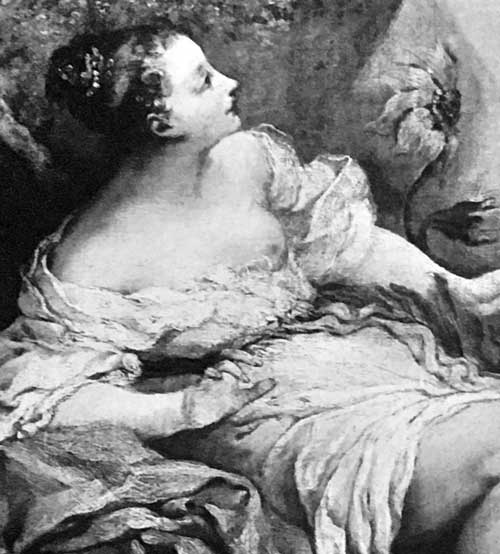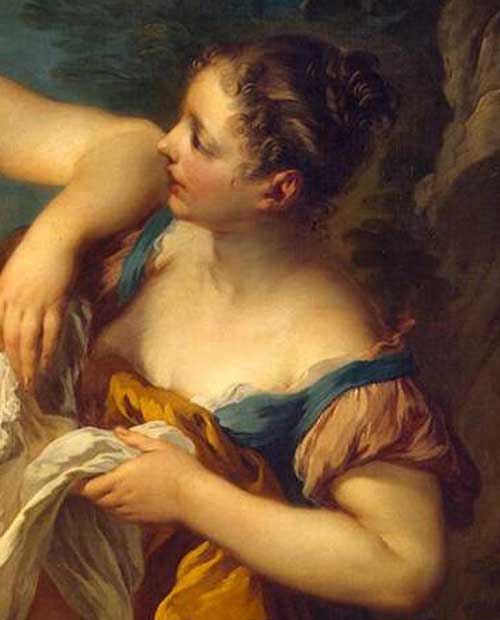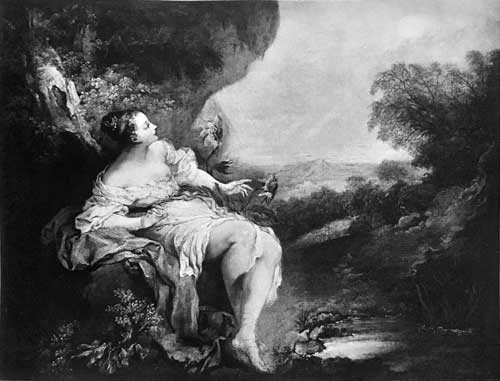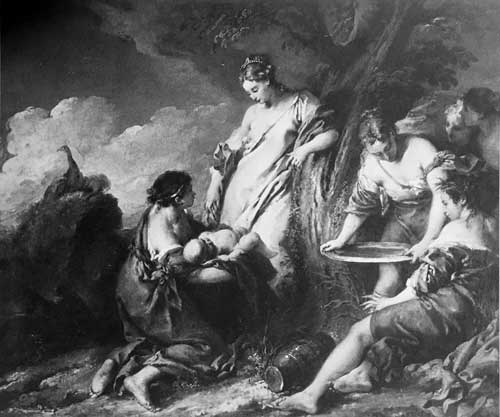
- Home Page
- Accepted
Paintings & Copies - Doubtful
Attributions - Doubtful Textual References
- Alternative
Titles - Collectors &
Museums - Bibliography
- Search Abecedario
- Watteau &
His Circle
X. Clytie adorant le soleil
Entered October 2017; revised December 2017
Pregny-Chambésy (Geneva), collection of baronne Nadine de Rothschild.
Oil on canvas
64 x 81 cm
ALTERNATIVE TITLES
Clytia
La Femme au tournesol
La Nymphe aux Tournesols
Die Nymphe mit der Sonnenblume
PROVENANCE
Paris, with Jules van Cuyck (art dealer)
Paris, collection of Paul Barroilhet (1810-1871; baritone singer). His sale, Paris, Hôtel des ventes mobilières, March 10, 1856, cat. 70: “DU MÊME [WATTEAU [ANT.] . . . Clytie adorant le soleil.”
Paris, collection of Paul Barroilhet. His sale, Paris, Hôtel des ventes mobilières, April 2-3, 1860, cat. 129: “WATTEAU (ANTOINE) . . . Clytie adorant le Soleil.”
Paris, collection of Baron Maurice de Rothschild (1881-1957; investment banker); by descent to his son, Edmond Adolphe de Rothschild (1926-1997; investment banker) and his wife, Nadine (b. 1932).
EXHIBITIONS
Paris, Galerie Martinet, Collections d’amateurs (1860), cat. 274 (as by Watteau, Clytie adorant le Soleil, lent by M. Van Cuyck).
Berlin, Werken französicher Kunst (1910), cat. 70 (as by Watteau, Die Nymphe mit der Sonnenblume, lent by Baron Maurice de Rothschild). In the French edition: Exposition d’oeuvres de l’art français, cat. 144 (as by Watteau, La Femme au tournesol, lent by Baron Maurice de Rothschild).
SELECT BIBLIOGRAPHY
Thoré-Bürger, “Exposition de tableaux” (1860), 274.
Graul, “Die französische Kunstausstellung” (1910), 116.
Meier-Graefe, “Correspondance d’Allemagne” (1910), 264.
Vaudoyer, “Exposition d’oeuvres de l’art français” (1910), 3, 12.Gillet, “Un Siècle d’art français” (1910), 223.
Zimmerman, Watteau (1912), no. 158.
Dacier, Vuaflart, and Hérold, Jean de Jullienne et les graveurs (1921-29), 1: 176.
Adhémar, Watteau (1950), cat. 265.
Wilhelm, “Lemoyne and Watteau” (1951), 222.
Bordeaux, Le Moyne (1984), cat. X15.
Vogtherr, Preti, and Faroult, Delicious Decadence (2014), 23, 92.
REMARKS
The attribution of this painting has long been debated. It was given to Watteau prior to 1860 but, that year, when it was shown at the Galerie Martinet, Thoré–Bürger noted how close it was in style to the work of François Le Moyne. Surprisingly, he concluded that it was indeed painted by Watteau but while under the influence of Le Moyne—an influence that Watteau never succumbed to. (Rather, it was Lemoyne who may have been influenced by Watteau.) While many scholars continued to believe Clytie was painted by Watteau, there were objections nonetheless. When the picture was shown in Berlin in 1910, Vaudoyer hesitated about the attribution to Watteau (“s’il est bien de maître”). Meier-Graefe announced that he was doubtful of the attribution and instead attributed it to an imitator of Boucher under the influence of Rubens. Gillet thought the painting too fluid and superficial, and proposed the name of François de Troy instead. A few years later, Zimmerman declared that he could not understand how people believed this was by Watteau, claiming that the landscape resembled English painting from the second half of the eighteenth century. Adhémar classified Clytie among paintings “autour de Watteau.” Most modern critics have not even mentioned the picture, implicitly excluding it from Watteau’s oeuvre. These include Réau, Macchia and Montagni, Roland Michel, Posner, Temperini, and Glorieux.
Adhémar claimed that a painting in the Doisteau collection, sold in 1909, lot 69, seemed close to this picture. In fact, there were three Doisteau sales in 1909, but only the June 9-16 sale contained eligible paintings, and lot 69 in that sale was an Assumption of the Virgin by Sebastiano Ricci. Was Adhémar proposing that Clytie was by Ricci?

Francois Boucher, Clytie adorant le soleil (detail).

François Lemoyne, Bather (detail). St. Petersburg, The Hermitage.
In recent years, there has been a noticeable shift toward attributing the painting to Lemoyne or Boucher. Dacier, Vuaflart, and Hérold pointed out that the nymph’s face was very close, in reverse, to the servant’s in François Lemoyne’s Bather. Probably unaware that Thoré-Bürger had reached a similar conclusion seventy years earlier, they attributed the painting to Lemoyne and wondered if it might have been part of a cycle by that artist for the duc du Maine. Two decades later, Jacques Wilhelm also attributed the painting to Lemoyne and situated it among a number of early Lemoyne works that were executed under the influence of Watteau (a direction of influence opposite to that proposed by Thoré-Bürger).

François Boucher, Clytie adorant le soleil.

François Boucher, La Naissance d’Adonis, oil on canvas, 60 x 82 cm. Private collection.
In his recent catalogue of Le Moyne’s oeuvre, Jean-Luc Bordeaux rejected Wilhelm’s attribution to Le Moyne and instead proposed that the painting was by the young Boucher working in the style of Watteau (although there is little to suggest Watteau here). Alastair Laing and Jamie Mulherron have informed me that they too believe it is by the young Boucher, but working under the influence of Le Moyne—a more convincing explanation. The picture should be compared with the artist’s early works, executed before he went to Italy, such as his Naissance d’Adonis. Laing also points out that there are two additional versions of this composition associated with Boucher’s name: one signed by the artist and measuring 73 x 86 cm, sold in Paris, April 26, 1873, Dhios de Labarté collection, lot 2; the other sold in Paris, Monsieur A. collection, January 17, 1803, lot 9, measuring 63.5 x 71.1 cm. Our painting measures 64 x 81 cm, which is not that far removed from the size of the one sold in 1803.
It should be noted that the subject of Clytie, although not the most common of myths from Ovid’s Metamorphoses, was depicted by many prominent artists: Annibale Carracci, Charles de la Fosse, François de Troy, and Charles Antoine Coypel.